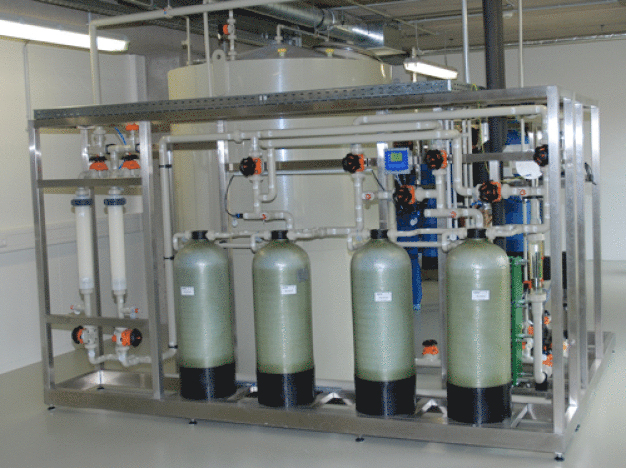- Hygiene & Cleaning
Ultra Pure Water – the process media
In research and production of electronic components for micro circuits, watches, medical devices or sensors the requirements to the cleaning medium ultra pure water are increasing more and more as the structural miniaturization increases in micro-technical components. This causes an ever-growing requirement for ion and particle-free and lowest TOC content in ultra pure water.
While the ultra pure water specifications for analysis or pharmaceutical applications usually in addition to the electrical conductivity only consider individual ions, microelectronics and microstructure technology offers a much wider range: Currently valid specifications in the field of a structure size <0.065 µm bump already to the detection limit of the analysis used; a permanent point of discussion between the needs of the microelectronics and equipment manufacturers.
The specifications are different and there are some some overlapping directives: considered the authoritative VDI 2083, ASTM D5129 or ITRS (International Technology Roadmap for Semiconductors). Each of these rules differs in accordance to different qualities terms of application, thus eg in the microstructure technology depending on the structure size range (1.2 down to 0.065 µm) eight different ultrapure water specifications are used, each differs the water quality within 35 parameters.
The production of ultrapure water takes place in several process steps, divided into the Make UP and polishing. The Make UP - the preparation of feed water to the storage tank - is realized almost invariably by a combination of conditioning, reverse osmosis and CEDI; the achieved quality is usually at <0.20 µS/cm, the storage tank is used for buffering of peak demand. The "polishing" then meets the requirements of microelectronics and microstructure technology as a final step. Since ultrapure water can not be stored with 18.2 Mohmxcm or 0.055 µS/cm without compromising quality, the polisher must be designed to the maximum possible flow rate within the system (or the loop line itself). The polishing is divided according to the request again in a number of process steps:
Immediately after the booster pumps a disinfection by UV light (254 nm) is carried out, even as oxidation (185 nm) to reduce organic components. The following residual desalination to the single-digit range ppt accepts a high-purity, specially for this application produced mixed bed ion exchanger by using semiconductor-grade ultrapure resin. Dissolved gases, special the oxygen which forces corrosion in semi conductor applications is reduced post to the ultra pure resin polisher by a vacuum membrane degasser, in some cases using high purity nitrogen as strip gas to reduce oxygen down to a few ppb. Particles are also undesirable in the field of microelectronics and microstructure technology, so the last step is always a micro- or ultrafiltration. Microfiltration is used for particle sizes from 0.2 to 0.05 microns; higher demands on the particle freedom are fulfilled by an ultrafiltration.
For the polishing Werner provides since over 30 years, specifically tailored made SUPERAQUADEM® polisher systems up to a capacity of 20 m³/h always designed to the customers requirements. This SUPERAQUADEM® system lines are individually equipped with all necessary process steps in accordance to the specified customer requirements. The modular design allows a further process step can also be added after year, for example if new requirements in the particle specification or dissolved oxygen shall be meet.
The piping of the components and also the realization of the loop occurs at Werner by an experienced and trained team of plastic welders with computer-controlled welding machines, either in non-contact infrared welding or bead and crevice free BCF® welding technology, in accordance to the requirements in some cases executed in a mobile laminar flow tent.
As a function of the specified purity requirements as materials beta-nucleated PP-H or PVDF has been established. Since the actual purification technology has not made revolutionary development steps in the last years, the current requirements are specified by the purity of the materials used, the production techniques and sustainability of water waste water balance. Werner ultrapure water systems benefit from the hygienic design of process and process technology in the pharmaceutical area for an extremely high quality of workmanship in the micro-structural area.
In addition to point-of-use compact systems for the production of ultrapure water for laboratory Werner GmbH provides a SUPERAQUADEM® ultrapure water system with components from the high-end industrial area.
![]()
EnviroFALK PharmaWaterSystems GmbH
Maybachstraße 29
51381 Leverkusen
Germany
Phone: +49 2171 7675 0
email: info@envirofalk-pharma.com
Internet: http://www.envirofalk-pharma.com









